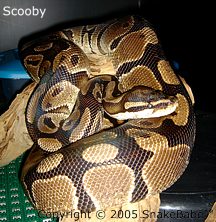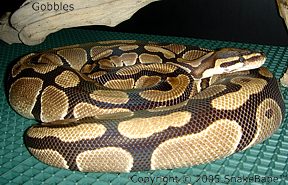African Royal Python aka Ball Python Care
 Common Name: Ball Pythons AKA Royal Python
Common Name: Ball Pythons AKA Royal Python
Scientific Name: Python Regius
Home Land: Africa
Size: 5-6 feet tops, usually not more then 4. Big enough to impress anyone and small enough to care for easily. Growth is not to fast.
Lifespan: I have heard up to 30 years and read reports of some getting as old as 50, but I don't know how true that is.
Cage:
I believe in more room than most. None of my baby's complain so I expect you to supply the same. Long enough to lie straight in and at least half his length deep. An easy to remove water bowl for cleaning that is big enough for your little guy to soak in comfortably. I use inexpensive but strong Rubbermaid bins. I can hose them out, scrub with a disinfecting detergent approved for animals and rinse. Make double sure caging is escape proof. If your little Houdini gets out and dies it's your fault. See my general care page on water bowls for more info. A hide house is strongly suggested. It gives these nocturnal snakes darkness during the day and security. I believe all reptile cages should have one. They need a place they can retreat to and feel safe. A cave like spot, not too big, where snakes can feel the walls while they sleep. Being able to touch all sides give them a feeling that nothing can sneak up on them while they rest. This helps keep them calm especially for snakes during the time they are digesting. For small snakes there are small logs split in half available. A heat source is very important. Do not use regular light bulbs. Do not use porcelain heat lamps in their cage if they can come in contact with it. Do not use hot rocks. This may sound like I am just trying to sell infrared heaters but I am not. Please read on. The only heat source I recommend for heating any reptile is Infrared heat panels. They warm the cage with ambient heat and if you touch them you will not burn! Reptiles will burn the flesh off their little bodies if you don't prevent this. I have taken in so many Iguanas and Snakes with burn patches on their bodies so if I can prevent one burn, I'll be happy. Hot rocks that are not on rheostats (heat controls) are too hot for smaller reptiles and are responsible for so many iguana deaths I scream at the pet shops when I see them. Porcelain heat lamps even as low as 50 watts can fry your skin like on a frying pan. The heat panels are warm to the touch. Measure the temperature by placing at least two thermometers on opposite sides of the cage a few inches off the ground level for your snake and top and bottom for climbing animals.
Substrate:
I have found that Drydeck (the rubber mats used behind most Bars and in kitchens at restaurants or in shower stalls) work great. They are raised off the ground so the pee runs under and your pet is not always walking or slithering through it and it hoses off easily for disinfecting. Wood chips can hold mites. Bark also. I have heard people use aspen bedding with success but do not feed you snake in the cage with any loosed substrate or they may ingest it when eating. These rubber mats have lasted me over 10 years now.
Behavior:
One of the best in the snake world. The reason he is called a Ball python is because many times when scared instead of biting he rolls up in a cute little ball covering up his tiny little head. How adorable. But that would mean he is scared and we do not want to frighten our new baby so with regular handling and lots of love he will lose that behavior and not care if he is handled. Even with the ball behaviour that is no guarantee you will not get bit. Be careful.
Temperatures:
I use heat panels to control all my reptile cages tempertaures. (see general care page) Since my cages are big enough as yours WILL be, keep one side at 80 degrees and have it increase up to 90 on the opposite side. Use two thermometers on each end of your cage to check and double-check this. You don't want to cook the little guy.
Humidity:
They do need humidity but it can be tough to clean. It makes your cage a great place for mold and bacteria to grow. Daily cleaning is a must. If you do not like that idea don't get the pet. Another way not so troublesome but better than nothing is to get a plastic shoe or sweater box at K-mart or such and fill the bottom with clean organic pesticide free dirt. (Find it in the gardening section.) If you cannot find that the T-Rex Forst Bedding works awesome, but I freeze it first for a few weeks just in case. Add enough water so that when you squeeze a handful it clumps up and breaks apart if you poke it with one finger. You don't want mud, just damp dirt. You'll get the idea when you try it. Then cut a hole in the lid big enough for your snake to climb through and he will hopefully go in there for his humidity. Not to good for big snakes but sufficient for the little guys like ball pythons and especially rainbow boas. It also acts as a great shelter for the smaller snakes too. One last thing here, pick up a hygrometer to keep track of the humidity. I have the digital thermometer/hygrometer combos but you can pick up inexpensive ones at Walmart or Radio Shack.
Shedding:
My guys shed approximately every 4-6 weeks. Your humidity bin and water bin will help the most during this process. If the eye caps (clear scale over the eyes) do not come off you have some special care coming up. This is scary because if you don't know what your doing you could blind the baby in helping him so I won't even recommend how to help except go to a vet and let them do it. I know vets are costly but if you can't afford it don't get the pet.
Feeding:
See "Alive or Dead" on general care page. Feed rodents or rats of appropriate size. Look at the roundest part of the snakes body and give them food that will fit in there without a lump. People have so many differences on frequency of feeding with snakes. I believe temperature and cage size can determine how much a snake will eat, not counting Burmese Pythons as they will gorge themselves if allowed to. I offer my adult Royal Pythons food every 7-10 days and sometimes they eat sometimes they don't. If they don't eat I'll try a few days later and typically they eat then. Hatchlings should eat once a week. I don't handle my snakes for a 2-3 days after they eat. Please never feed live food
This and That:
Royal Pythons are known for having unusual eating habits and they can go off feeding for a couple months at a time and if you don't know what you're looking for it could be due to illness and not just a normal fast. Always consult a vet (not a pet shop) if you are not sure. Handle for several short periods at first to get them used to handling and enjoy the animal!
This snake is a great pet if you have the money and space for its cage. It does not get to big to where it is difficult to handle and not to small to where it's a squirmy snake. I don't recommend it for really young kids but they make great pets for older ones.
